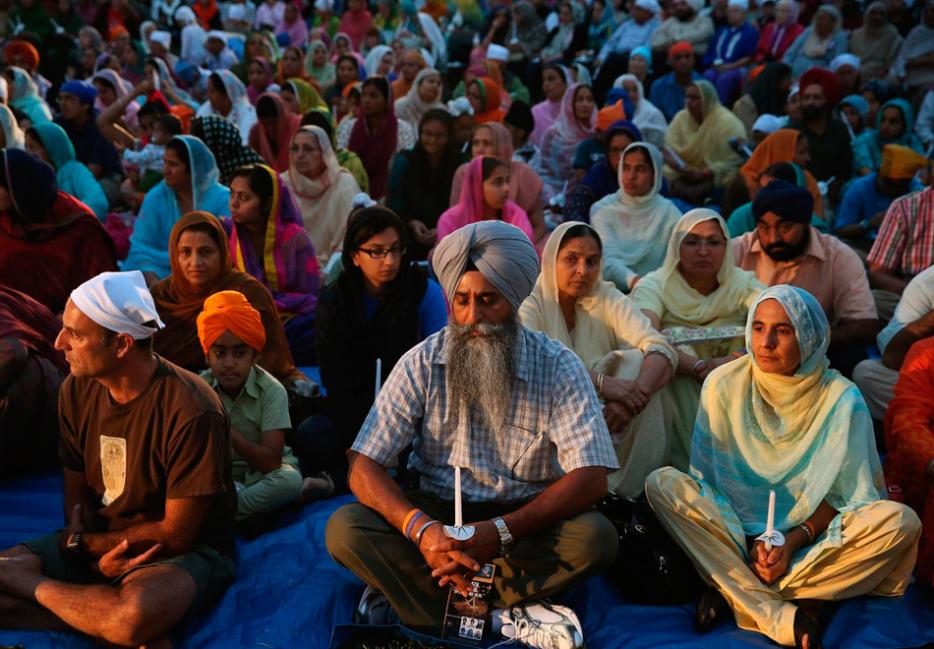You cannot extricate Sikhism from a single, defining question: what is demanded of you? It runs through the entire faith, but its genesis is probably the story of the panj pyare, one of the founding myths of the religion. In the late 17th century, Guru Gobind Singh, the final living Sikh leader, asked of his flock who would literally give his or her head for the faith. Daya Singh stepped forward and was led into a tent where the sound of a sword swinging was then heard, followed by a trickle of blood running out from under the fabric. Four more men followed to answer the call, and each time the same subsequent hint of a beheading.
It was, of course, in the classic way of the religious tale, a ruse—goats, not men, had had their heads cleaved off. Guru Gobind Singh later emerged from the tent hand-in-hand with the “five beloved ones,” and it was then that five markers of the religion—the familiar turban among them—were put into practice. The point of the fable? Henceforth, Sikhs would always have to visibly mark themselves out as Sikhs, never permitted to shy away from their responsibility to stand up for the faith or to fight for the oppressed.
What a twisted cosmic joke, then, that it was such visibility that, just over a year ago, led to the murder of six Sikhs by a white supremacist in a temple in Oak Creek, Wisconsin. Paramjit Kaur Saini, Prakash Singh, Ranjit Singh, Satwant Singh Kaleka, Sita Singh, and Suveg Singh Khattra, all dead not just because of how they identified, but because of how easily they were identified. And so, once again, nearly 30 years after burning tires were placed around the necks of Sikhs during the Delhi riots while the police looked the other way, the same question, tinged with history’s inescapable influence: What does murderous hate demand of you?
I don’t know the answer. How could I? Six people who looked like my extended family were murdered in a house of peace and worship. But if a coherent response to such profound violence is impossible, I still find myself clinging to a very weak one, unexpectedly using the strangest of words to now describe my relationship to Sikhism: we.
We. Us. These aren’t words I’d ever resorted to using before to talk about religion. I was raised in a house in which Sikhism, like the painting of Guru Nanak tucked away in a bedroom upstairs, always lingered around the edges, but never featured prominently. My mother believed, but only in a general idea of God; my father preferred biology labs, the Romantics and Sufi poetry to Sikh scripture. As a teen and into my twenties, when asked what religion I was, I used to answer “my parents are Sikh,” both because it was honest and because I used to be exactly the sort of aggressive, Nietzsche-quoting atheist I’ve since come to detest.
But my sudden turn to talking about Sikhism using that particular pronoun stems from the impossibility of that kind of privileged distancing—that dismissive rejection of culture, heritage and community—in the light of a hate-filled mass murder. Moving through the usual second-generation immigrant questions of identity is one thing; responding to people like you being killed is quite another altogether. So there it is. “We.” We Sikhs. That’s who I am now.
In another way, though, identifying as Sikh is also about the same demands of visibility. There’s always been an odd irony that, despite the fact that a smiling Sikh shows up in every idealized image of multiculturalism, Sikhs remain somewhat unseen, or at least misunderstood. I can’t tell you the number of times in my life I have stood in rooms of (mostly white) Canadian writers and academics—the intelligentsia, if you want—and had to spell out the very basic ideas of what Sikhism is to those I thought should know better. When the Oak Creek massacre happened, news reports lit up to “explain” Sikhism, as if one of the world’s major religions were some mystical cult. It sounds like melodramatic hyperbole, but it literally took some of us being murdered for “mainstream society” to give a shit about who we are—or indeed, to consider that we might also be part of this so-called “mainstream.”
At the same time, it also took this latest act of violence to force an end to my own ambivalent dance around an identity. It’s not so much that I chose to admit “who I really am”—such essentialist ideals help no one—as much as I decided to lay claim to something in which I was implicated. My answer to the question “what religion are you?” isn’t so defensive anymore. I no longer feel like I have the luxury of such evasion, and instead, with my body and the voluntarily worn markers of my kind, I must represent. I must stand for something, and speak as part of something, too.
What does murderous hate ask of you? It demands that you take a side—that you identify. It demands you eschew the nonsense of a “neutral” or “normal” identity and claim a definite one. I don’t quite know what the implications of that are—of whether there’s a lesson to be learned about identity politics, the oppositional nature of defining oneself, or, God, even “radicalization.” But this is the situation. You must decide what kind of markers to place on yourself. And when only death makes one’s identity visible to others, what choice do you have other than to achingly say, joined with others in loss, “I am Sikh”?






